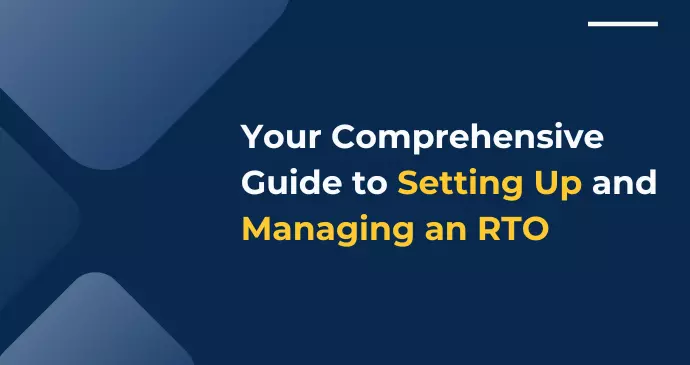
Your Comprehensive Guide to Setting Up and Managing an RTO
Setting up and managing a Registered Training Organisation (RTO) is a multifaceted endeavor that requires meticulous planning, adherence to regulations, and a relentless commitment to quality education.
Whether you’re an aspiring entrepreneur venturing into the education sector or an existing business expanding its services, this comprehensive guide will walk you through the essential steps for a successful RTO setup.
Understanding RTO Registration
Becoming an RTO involves navigating a complex process. Let’s delve deeper into the critical aspects:
1. Registration Process
- Application Preparation:
- Begin by meticulously preparing your application for RTO registration. The Australian Skills Quality Authority (ASQA) oversees this process.
- Gather all necessary documents, including your business plan, financial projections, and evidence of compliance.
- Site Visit:
- ASQA may conduct a site visit to assess your facilities, resources, and compliance readiness.
2. Key Considerations
- Business Strategy Document:
- Develop a comprehensive business strategy that addresses the following:
- Justification: Clearly articulate why you want to become an RTO. What unique value will your organization offer?
- Market Analysis: Identify your core market segment and tailor your services accordingly.
- Operational Structure: Outline your organizational structure, staffing requirements, and reporting lines.
- Risk Assessment:
- Understand and mitigate the risks associated with RTO operations, including financial, legal, and reputational risks.
Critical Success Factors for RTOs
While each RTO is unique, certain success factors apply universally:
1. Quality Assurance
- Standards Compliance:
- Align rigorously with the Standards for Registered Training Organisations (RTOs 2015). These standards cover areas such as training and assessment, student support, and facilities.
- Regularly review and update your training materials and delivery methods to maintain compliance.
- Continuous Improvement:
- Implement robust processes for ongoing quality improvement. Seek feedback from students, trainers, and industry stakeholders.
2. Student-Centric Approach
- Student Experience:
- Prioritize the entire student journey, from enrollment to completion.
- Offer personalized support, address individual needs, and create a positive learning environment.
- Support Services:
- Provide academic guidance, counseling, and pastoral care. Ensure students feel supported throughout their learning journey.
3. Effective Marketing and Recruitment
- Targeted Marketing:
- Understand your niche market and tailor your marketing efforts accordingly.
- Leverage digital channels, industry events, and partnerships to attract potential students.
- Industry Partnerships:
- Collaborate with employers, industry bodies, and other stakeholders.
- Build credibility and enhance job placement opportunities for your graduates.
Preparing Your Application
Your application for RTO registration is a critical step. Demonstrate your commitment to quality education through the following:
1. Business Plan
- Mission and Vision:
- Clearly articulate your organization’s purpose and long-term goals.
- Financial Projections:
- Provide realistic forecasts, including revenue, expenses, and investment requirements.
- Marketing Strategy:
- Explain how you’ll attract and retain students.
2. Staffing and Resources
- Qualified Staff:
- Employ trainers and assessors with relevant qualifications and industry experience.
- Invest in their professional development.
- Facilities and Equipment:
- Ensure you have adequate resources for effective training delivery.
Operational Considerations
As you set up your RTO, pay attention to the following operational aspects:
1. Course Development
- Training Packages:
- Choose relevant training packages aligned with industry needs.
- Customize these packages to meet specific learner requirements.
- Assessment Design:
- Develop fair, valid, and reliable assessment tools.
- Regularly moderate assessments to maintain consistency.
2. Compliance and Reporting
- Data Management:
- Maintain accurate records of student progress, assessments, and outcomes.
- Be audit-ready by organizing your documentation systematically.
Ensuring Quality Practices
Quality assurance is paramount in RTO management:
1. Trainer Competence
- Professional Development:
- Invest in ongoing training for your trainers.
- Ensure they stay updated with industry trends.
- Assessment Integrity:
- Follow best practices in assessment design and delivery.
What are some common mistakes to avoid when setting up an RTO?
- Insufficient Planning and Research:
- Mistake: Rushing into RTO setup without thorough planning.
- Solution: Invest time in researching market demand, competition, and regulatory requirements. Develop a robust business plan.
- Neglecting Legal and Compliance Aspects:
- Mistake: Ignoring legal obligations and licensing requirements.
- Solution: Register your business entity, obtain necessary permits, and comply with regulations from the outset.
- Underestimating Infrastructure Needs:
- Mistake: Failing to secure suitable premises, equipment, and technology.
- Solution: Assess resource requirements early and allocate sufficient budget for infrastructure.
- Incomplete or Weak Application for RTO Registration:
- Mistake: Submitting an incomplete or poorly prepared application.
- Solution: Craft a comprehensive application, including a solid business strategy and financial projections.
- Ignoring Risk Assessment:
- Mistake: Not assessing risks associated with RTO operations.
- Solution: Identify risks (financial, legal, reputational) and develop mitigation strategies.
- Lack of Quality Assurance Focus:
- Mistake: Neglecting alignment with RTO standards.
- Solution: Prioritize quality assurance, continuous improvement, and compliance with industry standards.
- Ignoring Student Experience:
- Mistake: Focusing solely on administrative processes.
- Solution: Create a student-centric environment, offer support services, and enhance the learning journey.
- Inadequate Marketing and Industry Partnerships:
- Mistake: Neglecting targeted marketing efforts and industry collaborations.
- Solution: Develop a marketing strategy, build partnerships, and promote your RTO effectively.
- Rushing Course Development:
- Mistake: Developing courses without proper alignment to industry needs.
- Solution: Choose relevant training packages, customize content, and ensure quality assessments.
- Poor Data Management and Reporting Practices:
- Mistake: Neglecting accurate record-keeping.
- Solution: Maintain student records, assessment outcomes, and compliance documentation meticulously.
Conclusion
Setting up and managing an RTO is not merely paperwork; it’s about transforming lives through education. By following these guidelines, you’ll create a valuable learning institution that contributes to individual growth and industry advancement.
Best of luck on your RTO journey!